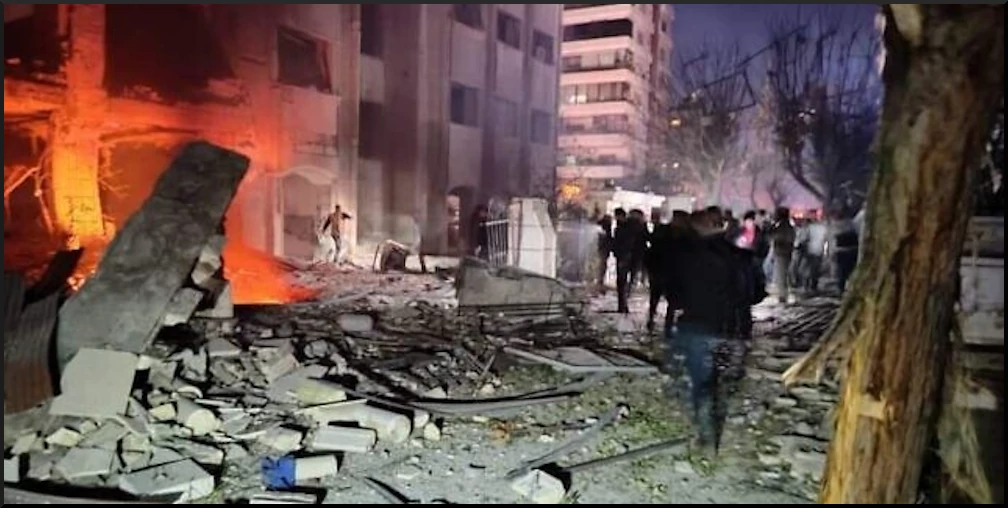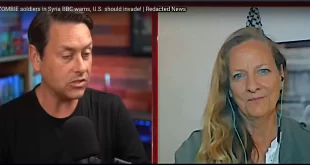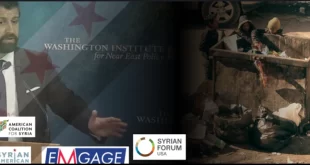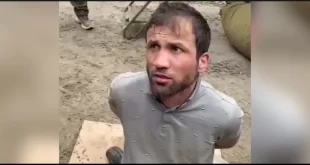Editor’s Note: An Article by Zvi Bare’el, first published in Ha’aretz on October 6, they day before the Hamas breakout, and later on MSN.com, talks about increasingly direct intervention in Syria if the U.S. occupation ends. They refer to the U.S. occupied area as ‘economically important’ while they talk about the groups vying for power there like a bunch of hyenas. Seems they want to increase the level of violence on Syria, but they might want to consider that the Syrian Arab Army is not a Hamas militia. Moreover, should they trigger a regional war, the Axis of Resistance would be their adversary. Such arrogance! Frightening all the same.
Israel Is No Longer a ‘Visitor’ in Syria’s Military Playground
by October 06th, 17PM
The level of destruction caused by the Israeli-attributed attack in Syria last Tuesday seems to point to a new strategy in the region, which extends beyond tactical operations and is likely coordinated with the U.S.
The airstrike on Tuesday on Iranian targets deep in Syria was attributed to Israel. It drew little attention, as if it were just another day at the office. According to Syrian media outlets, six “non-Syrians” were killed in the attack, as well as four Syrian civilians. News agencies explained that the attack was meant to hit the route used by Iran to supply weapons to Lebanon, but they also noted that this was unusual, since Israel usually hits targets in central or southern Syria.
It appears that this time, Israel wanted to exhibit what its capable of at a range of 700 kilometers (435 miles). However, the targets, near the city of Deir al-Zor, were situated in what’s considered the heart of Iran, the U.S. and Turkey and Syria’s military playground. The attack could thus draw Israel deeper into the region, a strategic stronghold sitting on an axis connecting Iraq to Syria.
The Syrian Democratic Forces, the military wing of the Autonomous (Kurdish) Administration of North and East Syria, which enjoy the sponsorship and support of the U.S., the Syrian regime and Iranian forces all struggle to control this area. This region is also very important economically, as its home to the largest gas field in the country, al-Omar, as well as other large oil fields, which were under the Syrian regime’s control until they were conquered in 2017 by Kurdish forces with assistance from the Americans. Revenue from these fields goes to the Kurds, financing their routine military and civilian operations. The U.S. placed its military bases near these fields, thereby affording protection to American companies operating them. This is the greatest booty the Kurds obtained in exchange for their essential participation in the war against ISIS, which they expelled from the district in 2019.
But the Kurds quickly learned that there is a difference between successful conquest of a region and its management. At first, they benefited from the full cooperation of the local population, most of which is Arab, belonging to four large tribes which, throughout most of the war, exhibited impressive opposition to the Syria regime. They now also oppose the regime’s ambition to fully dominate the region. The Kurds learned that ruling a tribal Arab population, even if it opposes Assad, obliges them to share management and resources. Recent years have seen clashes between local Kurdish commanders and tribe leaders, who saw their share in booty dwindling. There was almost no sharing in the process of decision making. Tribal leaders’ hopes were dashed – they believed that after the rout of ISIS and the transfer of control to the Kurds would lead to civilian rehabilitation in the area
The height of these clashes came late last August, when the supreme leadership of the Kurdish forces, centered around the city of al-Hasakah in northeastern Syria, decided to take action against Rashid Abu Khawla – who is known by several other names, too – whom they claimed was responsible for disputes and clashes between the regional council, under Kurdish jurisdiction, and the local tribes.
Abu Khawla, a leader of the Bakir tribe, one of the largest in the region, is colorful and controversial figure. Until the war, he headed a gang of motorcycle thieves and was arrested by the Syrian authorities. When the war broke out, he rushed to join the Free Syrian Army, the first military organization to lead the insurrection, but when ISIS took control of the region in 2014, he joined its ranks, but then fled to Turkey after the organization executed his brother.
When he returned to Syria two years later, he set up a private militia which later joined the Kurdish forces. Due to his close relations with Arab tribes and especially since he himself had become a sort of leader of his tribe, the Americans pushed Kurdish leaders, against their will, to appoint him as the military commander of the Deir al-Zor council. The Americans, it appears, believed that Abu Khawla could prevent renewed recruitment of tribe members, particularly of his own tribe, by ISIS.
Abu Khawla’s American backing and his tribal status bolstered his ambitions and exacerbated the clashes between him and local Kurdish leaders, as well as between him and the leader of all Kurdish forces in Syria, Mazloum Abdi. Things deteriorated to such an extent that Kurdish commanders, who were officially in charge of managing the Deir al-Zor district, found it difficult to implement civilian and military policies in the face of the independent and corrupt conduct of Abu Khawla, who knew how to forge ties with tribal leaders by granting them favors, thereby building a military and civilian power center that threatened the Kurdish leadership’s ability to rule.
On August 27, Abu Khawla was “invited” to a work meeting with the commander of Kurdish forces in al-Hasakah. When he and some of his aides arrived, they were arrested, a move which immediately cause an unprecedented violent clash between Kurdish forces in Deir al-Zor and tribal forces loyal to Abu Khawla. Estimates are that 150 people were killed in these clashes before a ceasefire was reached, through American intervention.
However, what seems like an internal clash between an ambitious commander and his bosses, or an ethnic scuffle between Arabs and Kurds, could threaten strategic American interests in northern Syria. Ethnic and tribal rivalry in the region is already being exploited by Iran, which reaches out to Arab tribes in an effort to recruit them to its side.
Iran is also establishing bases along the axis connecting Bukamal on the Iraqi border with Deir al-Zor (which is used to transfer medium-range missiles from Homs) and occasionally carries out missile attacks on the U.S. base at al-Omar. Its making an effort to invest in civilian services in the region, such as opening schools, purchasing books and learning materials, and paying salaries to Syrian teachers who resigned from the government system due to lack of pay. Simultaneously, its recruiting civilians, including women, for service in pro-Iranian militias.
In June, several Syrian news sites reported the establishment of a female military company called al-Zahra, expected to operate under the pro-Iranian al-Bakr militia and to focus on intelligence collection. According to reports, these women, who are primarily Syrian, but also Lebanese and Iraqi, receive salaries ranging from 250 to 450 dollars a month. Some of them get drugs at reduced prices, which they can then sell at market price and pocket the difference. The commander of the al-Bakr militia, which was established by Iran and operates under the guidance of Maher al-Assad, the brother of President Bashar Assad and the commander of the Syrian army’s Fourth Division, is Nawaf Ragheb al-Bashir, who announced the establishment of another Iran-supported militia last month.
Al-Bashir is also a leader of the al-Bakara tribe, which consists of groups of the larger families in the region, making him strategically important for Iran – which hopes to expand its recruitment of the local population, reduce Kurdish influence, displace tribal forces that oppose Assad and dispel American forces from Syria. This strategy attests to the extent of Iran’s far-reaching goals, which stretch beyond the dispatch of arms convoys to Lebanon or the establishment of military bases.
The complexity of local forces, with the various militias, parts of tribes, ethnic rivalries and ambitious local leaders, is a space in which Iran and the Syrian regime know how to play much better than the Americans do. The range of impact of American forces, numbering 900 combatants and instructors, is limited, despite the aerial support the American administration provides the Kurds. The temporary success of pro-Iranian tribal militias, which conquered a few villages near Deir al-Zor last month, only to be returned to Kurdish control after a few difficult days of fighting, makes clear that the battle is not over, and will continue to focus on control of the area and its gas and oil fields
In order to expand tribal support or neutralize flash points and reduce Iranian influence, the Kurds will need to contribute to tribal leaders, which means giving up some of the oil and gas revenues, investing in infrastructure and changing the structure of the military and civilian council that runs the region – so that the status of tribal leaders accurately represents their force.
The problem is that Kurdish leaders, even if willing to make concessions, will still have to contend with the uncertainty that comes with America’s Syria policy. President Trump’s decision in 2019 to withdraw U.S. forces posed a difficult political dilemma for the Kurds, forcing them to hold negotiations with Syria to bring it back under the regime’s, and not Kurd’s, control.
The Americans walked back on their decision, mainly due to pressure from Congress and European countries, but it rattled the Kurds, who saw how the U.S. crutch they relied on could suddenly change direction. The Kurds are now closely following attempts at conciliation between Syria and Turkey, encouraged by Russia, knowing a rapprochement could lead Turksih forces to withdraw from the region and be replaced by Syrian soldiers. For now, conciliation efforts are failing precisely due to Assad’s insistence on a Turkish withdrawal even before negotiations commence.
These diplomatic developments, along with Iran’s efforts to expand its influence and control in eastern Syria, should worry Israel more than the arms convoys making their way from Syria to Lebanon. If the Kurds lose control of eastern Syria, the route from ran, through Iraq, to Syria and Lebanon, will be a “racetrack” free of obstacles – all under the formal control of the Syrian regime, but controlled in practice by Iranian militias and the Revolutionary Guards.
Should this occur, Israel may need to need to intervene much more intensively than through sporadic airstrikes. It seems both Israel and Washington are aware of this. The destruction caused by the attack attributed to Israel last Tuesday, in which civilian infrastructure and bridge were also hit, could point to a new strategy that extends beyond tactical operations. It’s safe to assume that the change in the nature of Israel’s airstrikes and targets is coordinated with the Biden administration, whose military operations against Iranian targets are limited for diplomatic reasons (unless U.S. bases are attacked). If this is so, it appears Israel is no longer a “visitor” in Syria, but a player that, moving forward, is actively forming a shared strategy with the U.S
 Syria Support Movement solidarity with the Syrian people
Syria Support Movement solidarity with the Syrian people





